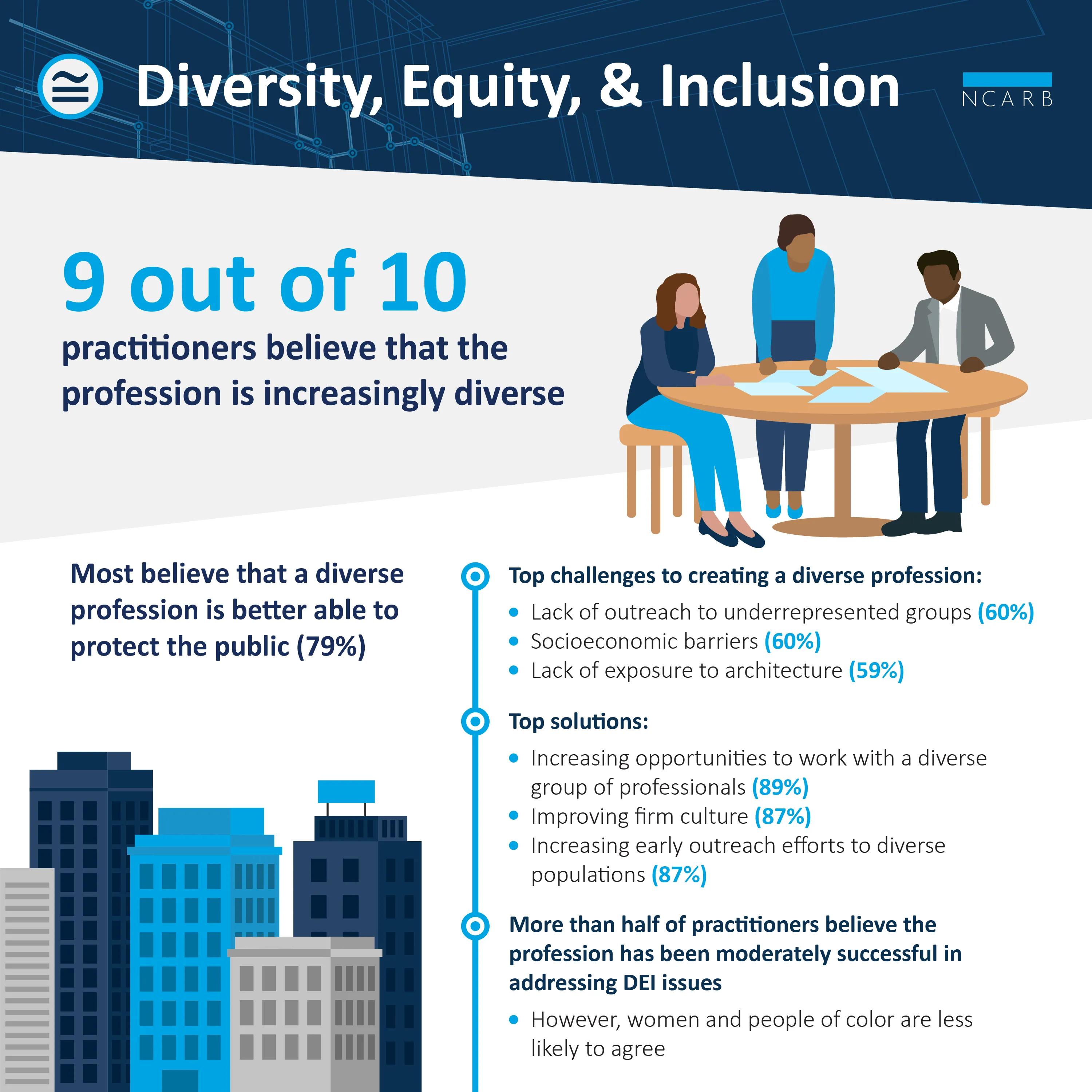NCARB is committed to encouraging greater diversity, equity, and inclusion (DEI) throughout all aspects of the NCARB community, including on the path to licensure. As part of the Analysis of Practice, NCARB asked thousands of architects, licensure candidates, and other collaborators to share their perspective on the fairness of the licensure process and how the profession is addressing DEI issues.

Addressing DEI Issues
Most respondents (82%) indicated that their employer was at least moderately successful in addressing DEI issues. However, significantly fewer respondents felt that regulatory and professional organizations were at least moderately successful in addressing those issues (58% and 54%, respectively).
The majority of respondents agreed that diversity is increasing within the architecture profession (87%) and that a diverse profession would better protect the health, safety, and welfare of the public (79%).
DEI Challenges and Solutions
Respondents identified many DEI issues that exist within the profession that have not been adequately addressed. The top five included:
- Lack of outreach to underrepresented communities/schools (60%)
- Socioeconomic barriers (60%)
- Lack of exposure to the architecture profession (59%)
- Lack of equal compensation (56%)
- Lack of career options for caregivers/families (56%)
When asked which strategies might best foster greater diversity within the profession, respondents indicated:
- Increasing the number of real-world experiences that involve working with a diverse group of professionals (89%)
- Improving firm culture (87%)
- Beginning outreach efforts to diverse populations early in the education cycle (including, but not limited to elementary education) to introduce them to architecture (87%)
- Hiring, promoting, and highlighting success stories of underrepresented groups (76%)
- Providing additional financial support to underrepresented students will help the next generation of architects be more diverse (75%)
Demographic Differences
Questions related to diversity, equity, and inclusion revealed greater disparity across demographic groups compared to most other topic areas within the Analysis of Practice—especially related to how successfully the profession was addressing DEI issues and personal experience with discrimination.
- 60% of men felt the profession was at least moderately successful in addressing DEI issues, compared to 38% of women
- 55% of white respondents felt the profession was at least moderately successful in addressing, DEI issues, compared to 28% of Black or African American respondents
- Women were nearly three times as likely as men to witness/experience gender discrimination at their workplace (41% vs 14%)
- Black or African American respondents were nearly five times more likely than white respondents to witness/experience racial discrimination at their workplace (42% vs 9%)
What’s Next?
Over the coming years, NCARB will continue evolving the licensure process, including exploring additional ways to encourage greater equity along the path to licensure. We look forward to sharing more insights from other sections of the Analysis of Practice with you in the months ahead.
About the Analysis of Practice
In 2022, over 19,000 individuals across the architecture, engineering, and construction (AEC) industry participated in NCARB’s once-in-a-decade Analysis of Practice study. Through a series of short questionnaires, focus groups, a final extensive survey, and more, NCARB gathered key insights about the field of architecture that will help shape the licensing model of the future. Results from the study will help us better understand the ecosystem of architectural practice and may lead to changes to NCARB’s national licensing programs and standards of the future.